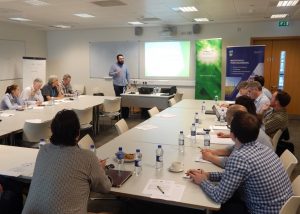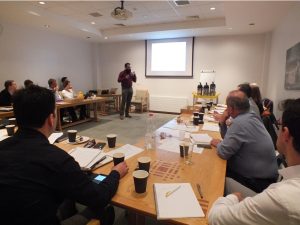Conference Presentations and Networking Tips for Beginners – By David Kelleghan
BLOG
 It can be daunting attending a conference for the first time, especially if you’re presenting a poster or giving a presentation. I remember the first talk I ever gave at a conference; feeling too stressed to finish my morning’s sausage sandwich. I had given presentations before during my undergraduate degree, but the audience to those were class members – this would be the first time presenting to an audience of unknown potential experts. When it came time for me to present, I stood up and talked for the required time and answered the required questions. It was immediately a blur, as I was running primarily on adrenaline (and only half a sausage sandwich). In hindsight, the build-up beforehand was much worse than the thing itself; hours stressing for a mere 15 minutes in the spotlight. Since then, thankfully, both my competence and communication skills have improved. I’ve learned that the more presentations you give and the more conferences you attend, the better you become at presenting your work and mingling with your peers. Since my first conference, I have presented my work on numerous occasions, at an array of conferences and interagency meetings, both nationally and internationally. I have also discussed my work on Television and Radio. Over this time, I have developed several useful “Pointers for Presentations” I would give to anyone about to present at a conference for the first time.
It can be daunting attending a conference for the first time, especially if you’re presenting a poster or giving a presentation. I remember the first talk I ever gave at a conference; feeling too stressed to finish my morning’s sausage sandwich. I had given presentations before during my undergraduate degree, but the audience to those were class members – this would be the first time presenting to an audience of unknown potential experts. When it came time for me to present, I stood up and talked for the required time and answered the required questions. It was immediately a blur, as I was running primarily on adrenaline (and only half a sausage sandwich). In hindsight, the build-up beforehand was much worse than the thing itself; hours stressing for a mere 15 minutes in the spotlight. Since then, thankfully, both my competence and communication skills have improved. I’ve learned that the more presentations you give and the more conferences you attend, the better you become at presenting your work and mingling with your peers. Since my first conference, I have presented my work on numerous occasions, at an array of conferences and interagency meetings, both nationally and internationally. I have also discussed my work on Television and Radio. Over this time, I have developed several useful “Pointers for Presentations” I would give to anyone about to present at a conference for the first time.
Pointers for Presentations:
- Talk slowly, loudly and clearly – I always find this one difficult, but try to treat your presentation as a marathon, not a sprint. I always speak much too quickly and need to remind myself to slow down. This can be especially problematic if you’re presenting to an international audience, where English may not be everyone’s first language. I experienced this recently, when I was presenting to an audience of international experts – I felt they were looking at me as if I didn’t know what I was talking about. Afterwards, in discussion with an audience member, they told me it was because I was speaking so quickly that they had difficulty understanding me.
- Talk with passion – It’s important to be excited and interested in your work. If you’re not connected with it, the audience may lose interest. I always think of a presentation as a one person show, where you need to both get your message across and keep the audience entertained.
- Keep visual content clear and simple – Ensure your presentation slides or poster content is easily understandable. Not everyone in attendance will be familiar with the detail of your work, so you need to be sure it’s simple enough to be understood by everyone. Keep text to a minimum, and make best use of any imagery, graphs, visual aids available.
- Be prepared – It’s worthwhile writing a script, rehearsing it and saying words out loud at least once. If you can say them aloud once, you can do it again in front of an audience. That said, don’t be afraid to incorporate some improvisation on the day. The ability to improvise can be helpful if you’ve lost your place in your script or have lost your train of thought. There’s also no harm in preparing for all eventualities. Once, at a conference, I was stood in front of the audience ready to begin, when I realised they didn’t have my presentation on file. It’s useful to make sure you have a backup on a USB ready to go in case of emergencies.
- Tell a joke or two – This one is optional, but I always try to include some humour in a presentation. It can break up a long day of people talking about science and can do a lot to draw the audience in to your work. I’ve always been an advocate of the unfunny jokes, so don’t worry if comedy isn’t your strong suit.
- Have a water bottle – Worst-case scenario, you lose your train of thought… Stop, relax, take a drink of water and collect yourself. It may seem like a long break to you, but the audience will perceive it as you stopping to take a drink – it doesn’t interrupt your flow.
- Have a laser pointer – Don’t presume the conference will have these. I’ve been at many that don’t, so I always now take my own. This allows you to focus on your presentation, not the laptop in front of you, leaving you available to make the most of your “stage” and enhancing your ability to connect with the audience.
Another aspect of conferences that can be quite intimidating is networking and mingling with experts and peers in your field. Similarly, to public speaking, I used to find approaching individuals at conferences and events stressful as I’ve never considered myself to be very socially adept. I’ve never been one to start a conversation with a stranger, which is the biggest obstacle when trying to network. With time I’d like to think my skills have improved, and hopefully the people I now start conversations with randomly at conferences aren’t too perturbed! There are of course tips I would give anyone attending a conference for the first time, especially if they felt anxious about attending a conference for the first time by themselves. Presented below are my “Necessities for Networking”.
Necessities for Networking:
- Introduce yourself – Constantly. Introduce yourself to anyone and everyone; someone you sit beside on a bus attending a field trip, anyone you sit beside at dinner, in a talk, or stand beside at a poster presentation. It
 can feel a little weird, but it will definitely benefit you – where else will you have such a collection of relevant peers and experts to befriend?
can feel a little weird, but it will definitely benefit you – where else will you have such a collection of relevant peers and experts to befriend? - Don’t be afraid to reintroduce yourself – I always forget names, and I know I’m not the only one. It’s totally fine to say, “Sorry, I know I know you, but I’ve forgotten your name”. But if you must ask someone more than three times. it might be time to find another person to introduce yourself to!
- Keep in touch – Give them a business card (If you have them – I admittedly always forget mine) to anyone you talk to, then add them on LinkedIn, Facebook, Instagram, Twitter – whatever social media’s available. If you were discussing something in particular, it’s a good idea to follow up afterwards with a message. Chances are, you’ll see them again at future conferences and events, so start building that network of colleagues.
- The experts are people too – I always found it intimidating talking to the experts who have been working in their fields for years, but making normal conversation with them is a good way to start! If you have a speciality, mention it, but there’s no harm in having a normal chat at these events, when the content can be, at times, a little overwhelming. The break can be a bit of a relief.
- A funny story or two is always good to have in the bag – I usually save a self-deprecating tale about how my Tinder profile wound up going viral on YouTube, with a subsequent chain of misinterpretations through Irish public bodies. It’s a great icebreaker.
- Others are probably feeling as or more awkward as you – Remember this when applying the previously mentioned points. It’s totally okay to just walk up to people and start talking. They may very well be glad you approached them.
David Kelleghan, BSc, MSc, PhD, GradCIEEM is currently a graduate member of CIEEM and has represented Irish students on the Irish section CIEEM committee since 2016. He is an occasional lecturer and postdoctoral researcher at University College Dublin, Ireland. He specialises in ecological impacts of air pollution and geographical information systems.
@DavidKelleghan
Blog posts on the CIEEM website are the views and opinions of the author(s) credited. They do not necessarily represent the views or position of CIEEM. The CIEEM blog is intended to be a space in which we publish though-provoking and discussion-stimulating articles.

 can feel a little weird, but it will definitely benefit you – where else will you have such a collection of relevant peers and experts to befriend?
can feel a little weird, but it will definitely benefit you – where else will you have such a collection of relevant peers and experts to befriend?